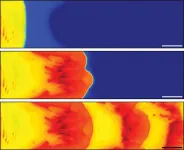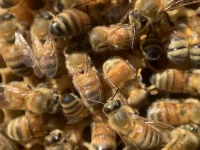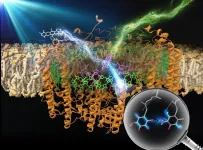(Press-News.org) Heavy elements known as the actinides are important materials for medicine, energy, and national defense. But even though the first actinides were discovered by scientists at Berkeley Lab more than 50 years ago, we still don't know much about their chemical properties because only small amounts of these highly radioactive elements (or isotopes) are produced every year; they're expensive; and their radioactivity makes them challenging to handle and store safely.
But those massive hurdles to actinide research may one day be a thing of the past. Scientists at the U.S. Department of Energy's Lawrence Berkeley National Laboratory (Berkeley Lab) and UC Berkeley have demonstrated how a world-leading electron microscope can image actinide samples as small as a single nanogram (a billionth of a gram) - a quantity that is several orders of magnitude less than required by conventional approaches.
Their findings were recently reported in Nature Communications, and are especially significant for co-senior author Rebecca Abergel (https://abergel.lbl.gov/), whose work on chelators - metal-binding molecules - has resulted in new advances in cancer therapies, medical imaging, and medical countermeasures against nuclear threats, among others. Abergel is a faculty scientist who leads the Heavy Element Chemistry program in the Chemical Sciences Division at Berkeley Lab, and assistant professor in nuclear engineering at UC Berkeley.
"There are still so many unanswered questions with regards to chemical bonding in the actinide series. With such state-of-the art instrumentation, we are finally able to probe the electronic structure of actinide compounds, and this will allow us to refine molecular design principles for various systems with applications in medicine, energy, and security," Abergel said.
"We demonstrated that you can work with less material - a nanogram - and get the same if not better data without having to invest in dedicated instruments for radioactive materials," said co-senior author Andy Minor, facility director of the National Center for Electron Microscopy at Berkeley Lab's Molecular Foundry, and professor of materials science and engineering at UC Berkeley.
Allowing researchers to work with just a nanogram of an actinide sample will significantly reduce the high costs of experiments conducted using previous methods. One gram of the actinide berkelium can cost a jaw-dropping $27 million, for example. An actinide sample that is only a nanogram also reduces radiation exposure and contamination risks, Minor added.
In one set of experiments at TEAM 0.5 (Transmission Electron Aberration-corrected Microscope), an atomic-resolution electron microscope at the Molecular Foundry, the researchers imaged single atoms of berkelium and californium to demonstrate how much less actinide material is needed with their approach.
In another set of experiments using EELS (electron energy loss spectroscopy), a technique for probing a material's electronic structure, the researchers were surprised to observe in berkelium a weak "spin-orbit coupling," a phenomenon that can influence how a metal atom binds to molecules. "This had never been reported before," said co-author Peter Ercius, a staff scientist at the Molecular Foundry who oversees the TEAM 0.5 microscope. "It's like finding a needle in a haystack. It's amazing what we could see."
Co-lead author Alexander Müller credits Berkeley Lab's interdisciplinary "team science" approach for bringing together the world's best experts in electron microscopy, heavy element chemistry, nuclear engineering, and materials science for the study.
"Because Berkeley Lab attracts amazing researchers from all fields of science, such interdisciplinary collaborative work comes naturally here," he said. "I personally found that aspect very rewarding for this project. And now that we have established this approach, we can pursue many new directions in actinide research." Müller was a postdoctoral scholar in Berkeley Lab's Molecular Foundry and UC Berkeley's Department of Materials Science and Engineering at the time of the study. He is now an associate at the Munich, Germany, office of Kearney, an international management consulting firm.
Safety protocols in place for the research involved sample preparation in dedicated laboratories and careful surveying of work areas. Since samples were prepared with miniscule amounts (1-10 nanograms) of each isotope, the contamination hazards to the equipment were also minimized, the researchers said.
The researchers hope to apply their approach to the investigation of other actinides, including actinium, einsteinium, and fermium.
"The more information we get from these minute amounts of radioactive elements, the better equipped we'll be to advance new materials for radiation cancer therapy and other useful applications," Minor said.
INFORMATION:
Co-authors on the paper include former Berkeley Lab postdoctoral scholar Gauthier Deblonde (co-lead author), now a research scientist at Lawrence Livermore National Laboratory, and Steven Zeltmann, a graduate student in UC Berkeley's Department of Materials Science and Engineering.
The Molecular Foundry is a DOE Office of Science user facility at Berkeley Lab.
The berkelium-249 and californium-249 chloride starting materials were supplied by the Isotope Program within the Office of Science.
This work was supported by the U.S. Department of Energy Office of Science. Additional funding was provided by the National Science Foundation.
Founded in 1931 on the belief that the biggest scientific challenges are best addressed by teams, Lawrence Berkeley National Laboratory and its scientists have been recognized with 14 Nobel Prizes. Today, Berkeley Lab researchers develop sustainable energy and environmental solutions, create useful new materials, advance the frontiers of computing, and probe the mysteries of life, matter, and the universe. Scientists from around the world rely on the Lab's facilities for their own discovery science. Berkeley Lab is a multiprogram national laboratory, managed by the University of California for the U.S. Department of Energy's Office of Science.
DOE's Office of Science is the single largest supporter of basic research in the physical sciences in the United States, and is working to address some of the most pressing challenges of our time. For more information, please visit energy.gov/science.
Nonalcoholic fatty liver disease (NAFLD) is a pathological condition characterized by excessive fat stored in the liver that is not attributed to heavy alcohol consumption, which can lead to liver failure and even cancer. Obesity, type 2 diabetes, and high cholesterol levels are all risk factors for this disease, and like the global prevalence of obesity, the prevalence of NAFLD is coincidently expected to rise as well.
It is therefore critical for clinicians to handle effective tools for diagnosing NAFLD. The current standard method for diagnosis is analysis of liver biopsy ...
Researchers led by TMDU fabricate a material that will aid bone healing, help medical practitioners clearly assess the full damage to bones after an injury, and clarify probable patient outcomes
Tokyo, Japan - Bone repair wasn't generally successful until the late 1800s. Until then, there were few options to repair major bone damage. Most materials don't have the functionality of bone and don't support blood vessels growing through them. Repair materials such as clay were commonly used yet often failed. In 1892, medical practitioners started using gypsum--calcium ...
Tobacco smoke-exposed children utilize emergency and urgent care services more often than unexposed children, which contributes to a large toll on the nation's health care system, says research led by the University of Cincinnati.
The study, recently published in the journal PLOS ONE, concluded:
· Children who are exposed to tobacco smoke have higher pediatric emergency department visit costs compared to unexposed children.
· A higher number of tobacco smoke-exposed children had an urgent care visit over a one-year period compared to unexposed children.
· Tobacco smoke-exposed children had nearly twice the risk of being admitted to the hospital over a one-year period compared to unexposed children. ...
Floating solar farms could help to protect lakes and reservoirs from some of the harms of climate change, a new study suggests.
However, given the complex nature of water bodies and differing designs of solar technologies, there could also be detrimental ecosystem impacts of deploying floating solar arrays.
Conventional solar farms are controversial due to the amount of land they take up. This is leading to increasing interest in floating solar farms - making use of the additional space that bodies of water provide.
So far, there are three commercial-size floating solar arrays in the UK, and hundreds more across the world. The number of installations is likely to grow significantly in coming decades as demand rises for renewable energy sources with more countries committing ...
For scientists, especially graduate students, who conduct fieldwork, every day is precious. Researchers meticulously prepare their equipment, procedures and timelines to make sure they get the data they need to do good science. So you can imagine the collective anxiety that fell across academia in spring 2020 when COVID-19 struck and many universities suspended in-person activities, including fieldwork.
But for Austin Green, a doctoral student in the School of Biological Sciences and 2019 recipient of a National Geographic Society Early Career Grant, who studies the wildlife that lives in the canyons of the Wasatch Front, that anxiety was tempered by the knowledge that pandemic or no pandemic, his network of automated ...
The largest flightless bird ever to live weighed in up to 600kg and had a whopping head about half a metre long - but its brain was squeezed for space.
Dromornis stirtoni, the largest of the 'mihirungs' (an Aboriginal word for 'giant bird'), stood up to 3m high and had a cranium wider and higher than it was long due to a powerful big beak, leading Australian palaeontologists to look inside its brain space to see how it worked.
The new study, just published in the journal Diversity, examined the brains of the extinct giant mihirungs or dromornithid birds that were a distinctive part of the Australian fauna for many millions of years, before going extinct around 50,000 ...
During the COVID-19 pandemic, people have grown accustomed to wearing facemasks, but many coverings are fragile and not easily disinfected. Metal foams are durable, and their small pores and large surface areas suggest they could effectively filter out microbes. Now, researchers reporting in ACS' Nano Letters have transformed copper nanowires into metal foams that could be used in facemasks and air filtration systems. The foams filter efficiently, decontaminate easily for reuse and are recyclable.
When a person with a respiratory infection, such ...
Nature produces a startling array of patterned materials, from the sensitive ridges on a person's fingertip to a cheetah's camouflaging spots. Although nature's patterns arise spontaneously during development, creating patterns on synthetic materials is more laborious. Now, researchers reporting in ACS Central Science have found an easy way to make patterned materials having complex microstructures with variations in mechanical, thermal and optical properties -- without the need for masks, molds or printers.
In animals, patterns form before birth ...
Honeybees play a scent-driven game of telephone to guide members of a colony back to their queen, according to a new study led by University of Colorado Boulder. The research, published today in the Proceedings of the National Academy of Sciences, highlights how insects with limited cognitive abilities can achieve complex feats when they work together--even creating what looks like a miniature and buzzing version of a telecommunications network.
The findings also serve as a testament to a honeybee's love for its queen. These matriarchs are the most important members of any hive: They're the only females able ...
Given the finite nature of fossil fuel reserves and the devastating environmental impacts of relying on fossil fuels, the development of clean energy sources is among the most pressing challenges facing modern industrial civilization. Solar energy is an attractive clean energy option, but the widescale implementation of solar energy technologies will depend on the development of efficient ways of converting light energy into chemical energy.
Like many other research groups, the members of Professor Takehisa Dewa's research team at Nagoya Institute of Technology in Japan have turned to biological photosynthetic apparatuses, which ...









